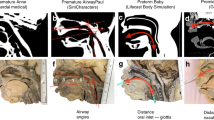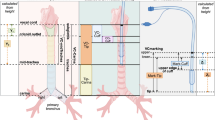Abstract
Objective:
Nasal-tragus length (NTL) estimates of endotracheal tube (ETT) depth are replacing weight-based estimates for endotracheal tube depth in neonates requiring endotracheal intubation. Existing neonatal simulators were designed before interest in using the NTL, and may lack fidelity in this measurement. The objective of this study is to evaluate the accuracy of the adjusted NTL formula and the Neonatal Resuscitation Program (NRP) gestational age/weight-based ETT depth chart in predicting proper endotracheal tube insertion depth in a cohort of neonatal simulators.
Study design:
The NTL and appropriate intubation depth to the mid-trachea were measured for 11 commonly used neonatal intubation simulators.
Results:
The NTL+1 cm formula incorrectly estimates the mid-tracheal depth in 82% of simulators, and the weight-based chart incorrectly estimates depth in 75% of test simulators. Only one simulator experienced a mainstem intubation with ETT insertion to the depth predicted by the NTL+1 cm formula.
Conclusions:
The majority of neonatal resuscitation simulations lacked physical fidelity with regard to mid-tracheal ETT insertion depth. The NRP gestational age/weight-based chart outperformed the NTL+1 cm formula but still resulted in endotracheal tube misplacement in the majority of neonatal simulators. The majority of simulators had adequate functional fidelity using either method for ETT depth estimation.
This is a preview of subscription content, access via your institution
Access options
Subscribe to this journal
Receive 12 print issues and online access
$259.00 per year
only $21.58 per issue
Buy this article
- Purchase on Springer Link
- Instant access to full article PDF
Prices may be subject to local taxes which are calculated during checkout

Similar content being viewed by others
References
Thayyil S, Nagakumar P, Gowers H, Sinha A . Optimal endotracheal tube tip position in extremely premature infants. Am J Perinatol 2008; 25 (1): 13–16.
Peterson J, Johnson N, Deakins K, Wilson-Costello D, Jelovsek JE, Chatburn R . Accuracy of the 7-8-9 rule for endotracheal tube placement in the neonate. J Perinatol 2006; 26 (6): 333.
Kempley ST, Moreiras JW, Petrone FL . Endotracheal tube length for neonatal intubation. Resuscitation 2008; 77 (3): 369–373.
Textbook of Neonatal Resuscitation, Weiner G (ed). 6th edn. American Heart Association: American Academy of Pediatrics: Elk Grove Village, Chicago, IL, 2011.
Tatwavedi D, Nesargi S, Shankar N, Rao S, Bhat S . Evaluation of body parameters for estimation of endotracheal tube length in Indian neonates. Eur J Pediatr 2015; 174 (2): 245–249.
Tochen ML . Orotracheal intubation in the newborn infant: a method for determining depth of tube insertion. J Pediatr 1979; 95 (6): 1050.
Shukla HK, Hendricks-Munoz KD, Atakent Y, Rapaport S . Rapid estimation of insertional length of endotracheal intubation in newborn infants. J Pediatr 1997; 131 (4): 561.
Wang T-C, Kuo L-L, Lee C-Y . Utilizing nasal-tragus length to estimate optimal endotracheal tube depth for neonates in Taiwan. Indian J Pediatr 2011; 78 (3): 296–300.
Textbook of Neonatal Resuscitation, Kattwinkel J (ed). 7th edn. American Academy of Pediatrics and American Heart Association 2016.
Leone TA, Rich W, Finer NN . Neonatal intubation: success of pediatric trainees. J Pediatr 2005; 146 (5): 638–641.
Hamstra SJ, Brydges R, Hatala R, Zendejas B, Cook DA . Reconsidering fidelity in simulation-based training. Acad Med 2014; 89 (3): 387.
Sawyer T, Strandjord TP, Johnson K, Low D . Neonatal airway simulators, how good are they? A comparative study of physical and functional fidelity. J Perinatol 2016; 36 (2): 151–156.
Curtis MT, DiazGranados D, Feldman M . Judicious use of simulation technology in continuing medical education. J Contin Educ Health Prof 2012; 32 (4): 255–260.
Fenton T, Kim J . A systematic review and meta-analysis to revise the Fenton growth chart for preterm infants. BMC Pediatrics 2013; 13: 59.
Harjeet SD, Batra YK, Rajeev S . Anatomical dimensions of trachea, main bronchi, subcarinal and bronchial angles in fetuses measured ex vivo. Paediatr Anesth 2008; 18 (11): 1029–1034.
McGaghie W . Simulation in professional competence assessment: basic considerations. Innovative Simulations for Assessing Professional Competence, vol. 722. Department of Medical Education, University of Illinois: Chicago, IL, 1999.
Maran N, Glavin R . Low- to high-fidelity simulation - a continuum of medical education? Med Educ 2003; 37: 22–28.
Author information
Authors and Affiliations
Corresponding author
Ethics declarations
Competing interests
The authors declare no conflict of interest.
Rights and permissions
About this article
Cite this article
Gray, M., Delaney, H., Umoren, R. et al. Accuracy of the nasal-tragus length measurement for correct endotracheal tube placement in a cohort of neonatal resuscitation simulators. J Perinatol 37, 975–978 (2017). https://doi.org/10.1038/jp.2017.63
Received:
Revised:
Accepted:
Published:
Issue Date:
DOI: https://doi.org/10.1038/jp.2017.63



